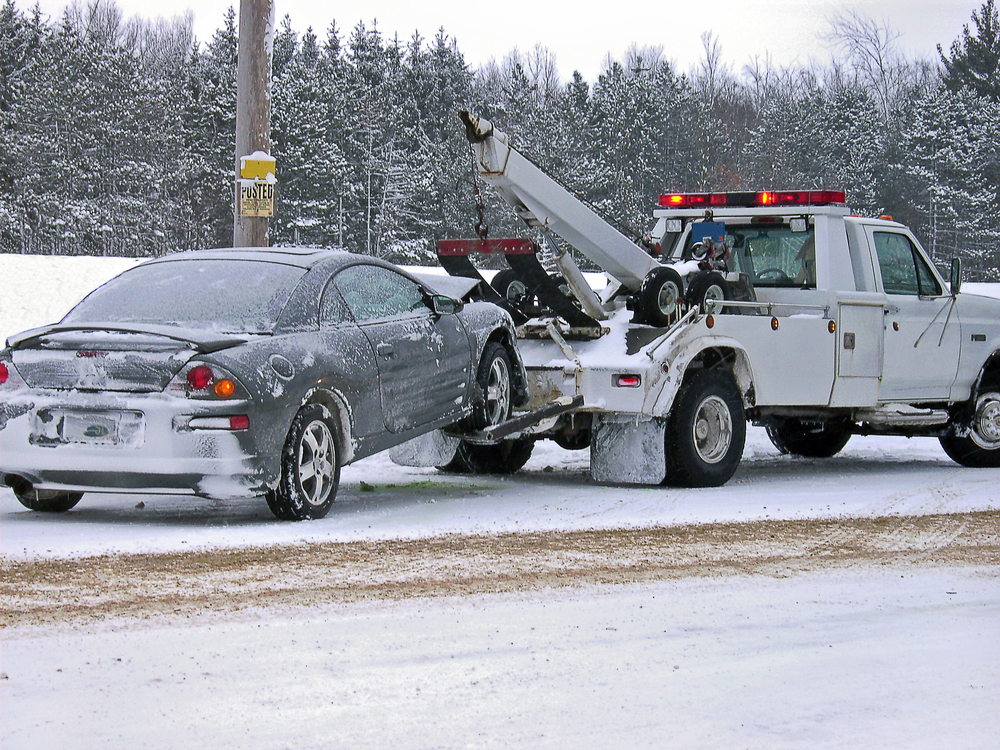Tips To Avoid Towing in the Winter

Winter brings stunning snowy landscapes, but it also ushers in challenging driving conditions. Snow, ice, and freezing temperatures can make even a short drive risky, increasing the chances of getting stranded and needing a tow. Fortunately, with a little preparation and some smart driving techniques, you can reduce the risk of getting stuck or losing control. In this post, we’ll share essential safety tips for winter driving to help you stay on the road and avoid an expensive and inconvenient towing situation.
Prepare Your Car for Winter Driving
Before you hit the road in winter, it’s vital to ensure your car is in optimal condition. Harsh weather can expose weaknesses in your vehicle, so preparing your car is the first step to avoiding trouble.
Check Your Tires
Tires are your first line of defense when driving in snowy and icy conditions. Ensure they are up for the challenge:
- Tread Depth: Worn-out tires lose grip on slippery roads. Use a coin or tread depth gauge to check your tires’ tread.
- Winter Tires: Consider switching to winter tires, as they provide better traction in cold temperatures.
- Tire Pressure: Cold air can lower tire pressure, so check it regularly to meet the manufacturer’s recommendations.
Keep Your Battery in Check
Cold weather strains your car’s battery, which can lead to unexpected breakdowns.
- Test your battery before winter hits.
- Clean the terminals and replace a weak or old battery if needed.
Maintain Fluids and Wipers
Your vehicle’s fluids and visibility systems are key for winter driving safety:
- Antifreeze: Top off antifreeze to keep your engine from freezing.
- Windshield Washer Fluid: Use a winter-specific formula to prevent freezing.
- Wiper Blades: Replace worn-out wipers and consider winter blades for heavy snow and ice.
Pack an Emergency Kit
Even the most prepared driver can encounter surprises. Keep an emergency kit in your car stocked with:
- Blankets, gloves, and warm clothing
- Flashlight and extra batteries
- Jumper cables
- Sand or kitty litter for traction
- Shovel and ice scraper
- Non-perishable snacks and water
By ensuring your car is winter-ready, you’ll minimize the risk of getting stranded and needing a tow.
Dos and Don’ts of Driving in the Snow
Knowing the dos and don’ts of driving in the snow can significantly improve your safety and help you avoid losing control. Let’s break them down.
DO: Drive Smoothly and Slowly
Speed and jerky movements are a recipe for disaster on snowy roads:
- Accelerate and decelerate gently to avoid skidding.
- Drive slower than usual and increase your following distance. It takes longer to stop on slippery surfaces.
- Use gentle steering to keep control.
DON’T: Slam on the Brakes
Braking abruptly on snow or ice can lock your wheels, causing you to slide. Instead:
- Use light, steady pressure on the brakes.
- If your car has an Anti-Lock Braking System (ABS), don’t pump the brakes—let the system work.
DO: Use Low Gears When Driving
If you’re driving a manual or automatic car with gear selection options:
- Shift into a lower gear to maintain better traction, especially on downhill slopes.
DON’T: Tailgate Other Drivers
The stopping distance in snowy conditions can be up to 10 times greater than on dry pavement. Keep a safe following distance to prevent collisions.
DO: Know How to Handle Skids
Skidding happens even to the best drivers. Here’s how to recover:
- Stay calm and avoid overcorrecting.
- For a rear-wheel skid, steer in the direction you want to go.
- For a front-wheel skid, ease off the gas and allow the tires to regain traction.
By following these dos and don’ts, you’ll improve your ability to handle snowy roads safely and reduce the chance of getting stuck or calling for a tow.
Safe Driving Practices for Icy Roads
Icy roads present an even greater challenge than snow. Black ice, in particular, is nearly invisible and extremely slippery. Follow these safety tips for winter driving to handle icy conditions effectively.
Recognize and Avoid Black Ice
Black ice forms on shaded areas, bridges, and overpasses. Here’s what to look for:
- Smooth, glossy patches on the road surface.
- Temperature near freezing (32°F or 0°C).
Slow down and drive with caution in areas prone to black ice.
Increase Your Stopping Distance
- Leave more space between you and the car ahead of you to allow for slower braking.
- Start slowing down earlier when approaching intersections or turns.
Avoid Sudden Maneuvers
Quick turns, lane changes, or braking on icy roads can cause your car to lose traction. Plan ahead, make slow movements, and always stay focused.
Monitor Weather and Road Conditions
One of the easiest ways to avoid towing in winter is by staying informed. Always check the weather forecast and road conditions before you head out.
Use Reliable Weather Apps
Download weather apps that provide real-time updates on snowstorms, icy roads, and winter advisories. Popular choices include:
- The Weather Channel
- AccuWeather
- Local news apps
Plan Your Route
If a major snowstorm is expected, consider delaying non-essential trips. If you must drive:
- Stick to main roads that are more likely to be plowed and salted.
- Avoid backroads and shortcuts, as they may be less maintained.
Keep Your Gas Tank Full
A full tank not only ensures you won’t run out of fuel but also adds weight to your car, improving traction.
Stay Calm If You Get Stuck
Even with all precautions, getting stuck in snow can still happen. The key is to stay calm and follow these steps:
- Don’t Spin Your Wheels: Spinning the tires can dig you deeper into the snow. Instead, gently rock the car back and forth by shifting between drive and reverse.
- Use Sand or Kitty Litter: Sprinkle sand, kitty litter, or traction mats under your tires to gain grip.
- Clear Around the Tires: Use a shovel to remove snow around your tires and under the car.
- Call for Help: If all else fails, stay inside your car to keep warm and call for roadside assistance. Always let someone know your location.
Conclusion
Driving in winter doesn’t have to be stressful if you take the right precautions. From prepping your car for the season to following the dos and don’ts of driving in the snow, these safety tips for winter driving will help you avoid trouble on the road. By staying informed, driving cautiously, and keeping your vehicle in peak condition, you can navigate snowy and icy roads confidently and reduce the chances of needing a tow.
Remember: preparation, patience, and smart driving are your best allies in winter. Stay safe, stay alert, and enjoy the winter season responsibly!
Need a Towing & Auto Repair Shop in Worcester, MA?
Here at Early’s on Park Avenue Inc., we’re dedicated to getting you back on the road with reliable, fast, and friendly service. Whether you need 24-hour towing, expert auto repair, or are looking for quality vehicles for sale, we’re here to help! As a family-owned business, we take pride in treating our customers like family and delivering top-notch service every time. Don’t wait—give us a call today and let us handle all your automotive needs!
